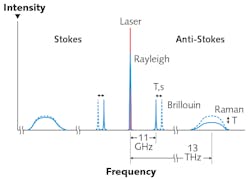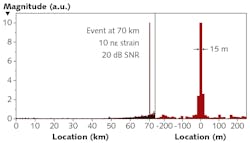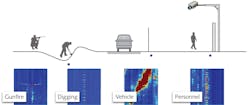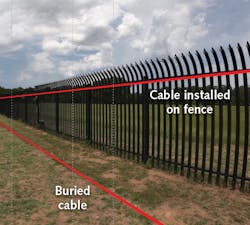WIELAND HILL, JOHN J. WILLIAMS, and GARETH LEES
Fiber-optic sensing systems based on elastic or inelastic light scattering effects in standard telecommunications-grade optical fibers are powerful tools for analyzing spatially resolved profiles of physical quantities along fiber-optic cables. Their success in multiple applications comes from the cost-effective measurement of thousands of locations with a single interrogator, the large distance range, the absence of electrical power in the application, and the immunity to electromagnetic interference.
Within the last 30 years, numerous technologies have been developed for distributed or multipoint measurement of physical quantities using optical fibers. Technologies using specially prepared fiber sections like fiber Bragg grating (FBG)-based systems gained relevance in monitoring equipment at single or multiple points. Truly distributed technologies using standard optical fibers without these reflective structures are, however, clearly dominating the surveillance of large infrastructure assets because of their capability to monitor thousands of locations, easy integration, reliable operation, and low price of the standard sensor cable.
Light-scattering mechanisms
Optical fibers exhibit three scattering processes that have been found to be extremely useful in measuring physical quantities like temperature, strain, or vibration (dynamic strain or sound) with high spatial resolution: Brillouin, Raman, and Rayleigh scattering (see table).Brillouin and Raman scattering are inelastic scattering processes involving energy transfer to or from thermal vibrations (optical and acoustic phonons, molecular vibrations). Rayleigh scattering is elastic scattering caused by static inhomogeneities of the refractive index. Each scattering process shows a characteristic spectrum with specific dependencies on the physical quantities to be analyzed (see Fig. 1).
Raman scattering is widely used in distributed temperature sensing (DTS). That is, DTS uses a simple optical filter scheme to measure the amplitudes of anti-Stokes and Stokes components and then calculates temperature profiles from their ratio.
Brillouin scattering requires a somewhat more complex detection scheme since its frequency shift with respect to the laser line is fairly small. The analyzed Brillouin frequency depends on temperature and strain, which often leads to the need to separate both parameters. This separation can be done by using a combination of loose-tube and tight-buffered fibers, where the loose-tube fiber only experiences the temperature effect, or by measuring the amplitude of the Brillouin signal as a second measurand enabling the separation.
Distributed acoustic sensing (DAS) is commonly based on coherent Rayleigh scattering. Interference of Rayleigh-scattered light from multiple scattering centers within the fiber leads to a speckle-like pattern that depends on the phase difference between the superposing light waves. This pattern is extremely sensitive to length changes within the fiber because a few tens-of-nanometers difference causes a considerable change of phase for light with a typical wavelength around 1.5 µm.
Measuring the amplitude of the Rayleigh signal is sufficient for sensitive detection of events with broad acoustic spectrum like walking, driving, shooting, and digging or tunneling, whereas a phase measurement is required for determining the frequency of narrowband signals from motors, pumps, or orifice sounds. However, phase information is always required for precise quantitative analysis of signals due to the strongly nonlinear behavior of the amplitude signal.
Application-specific sensing
Main application areas of Raman-based DTS are fire detection in tunnels and buildings, power cable monitoring, pipeline monitoring, and oil and gas in-well (or downhole) monitoring, as well as geothermal/environmental applications. In fact, DTS has already become the standard method of fire detection for rail and road tunnels in most regions of the world due to its reliable, cost-efficient, and fast alarming with precise fire localization in tunnels with a length up to 10 km by using a single interrogator (two interrogators are commonly used for achieving redundancy). Power cable monitoring by DTS is also becoming a standard method because with the transition to renewable energies, higher and stronger fluctuating loads must be transmitted by the grid without causing cable damage by overheating.
In addition to some of the more demanding DTS applications, Brillouin scattering is widely used in distributed strain sensing (DSS), mostly related to ground movements and their impact on physical infrastructure like pipelines, cables, dams, train tracks, bridges, tunnels, and buildings—often referred to as “structural health monitoring” applications.
Compared to DTS and DSS, modern DAS interrogators based on Rayleigh scattering demonstrate huge sensitivity (see Fig. 2). Periodic stretching of a 15-m-long fiber section by 10 nε (150 nm in total) results in a huge signal, even at a distance of 70 km. The observed spatial resolution for this very weak and remote event is only 15 m—even sub-nanostrain or few-nanometer resolutions are achieved at shorter distances.Appropriate fiber installation is another important topic. For detecting fence climbing or cutting, it is necessary to install the fiber on the fence. Then, one obviously needs dedicated algorithms for avoiding false alarms by ambient sound from wind or traffic. If one wants to detect footsteps or vehicle activity approaching a perimeter fence or wall or even a property without a physical barrier, it may be better to bury the cable. Then, airborne sound is greatly reduced, whereas structure-born sound is efficiently transmitted to the fiber.
It is common practice to have the sensing cable installed both on the fence and in the ground to improve the probability of detection of a threat while minimizing false alarm rate (see Fig. 4). A threat would be classified as an approach to the fence and then a subsequent disturbance on the fence at a nearby location.DAS in a border-security context
With the ability to detect border incursions in a persistent and continuous manner, DAS provides low-cost, early warning of border activity over long distances and can be integrated with other layers of security such as cameras or unmanned aerial vehicles (UAVs).
There are essentially two main concepts of operations (CONOPS) with DAS in a border security context. First, in an ‘urban-to-urban’ border environment such as San Diego and Tijuana in the U.S. and Mexico, rapid detection and integration with border patrols’ other layers of security is important to enable a rapid and appropriate response. This is also the CONOPS at key choke points along several Eastern European borders, where intervention is the aim and response times can be measured in minutes or hours.
In urban-to-urban areas, DAS can also provide subterranean activity detection, which is sometimes present in high-risk areas where tunnels are used for people or contraband trafficking.
The second main CONOPS with DAS is for remote border regions, where response and intervention times are measured in hours or even days. In this scenario, DAS still provides real-time detection, but not every detection is necessarily going to generate an immediate border management response. By providing persistent, continuous coverage and crucially—with all detection activity stored in an archive—border management can gain insights of border pattern of life over extended periods of time (see Fig. 5).Essentially, the DAS system can provide a heatmap of a border in terms of human activity and where there might be buildups of activity that require further attention. For example, if there is a trend of increased activity in a specific remote location along the border over a period of a week or a month, this could warrant a response from border management by applying additional technology or personnel in that specific location.
A physical barrier is a deterrent to border incursions and will likely slow down border crossings, but by itself it will not stop determined actors and it will not help border management understand what is happening along the border over time. Therefore, combining physical barriers with detection technology is crucial to a successful border security approach. Fiber-optic sensing is a cost-effective detection method over long distance that provides both real time information and archived pattern of life data over extended periods, which can aid in border security management and complement a physical barrier.
Wieland Hill is director of Advanced Sensing Systems at NKT Photonics, Cologne, Germany, www.nktphotonics.com; John J. Williams is regional director of infrastructure monitoring for the Americas at OptaSense, Houston, TX, www.optasense.com; and Gareth Lees is research director at AP Sensing, Boblingen, Germany, www.apsensing.com; e-mail: wieland.hill@nktphotonics.com.





